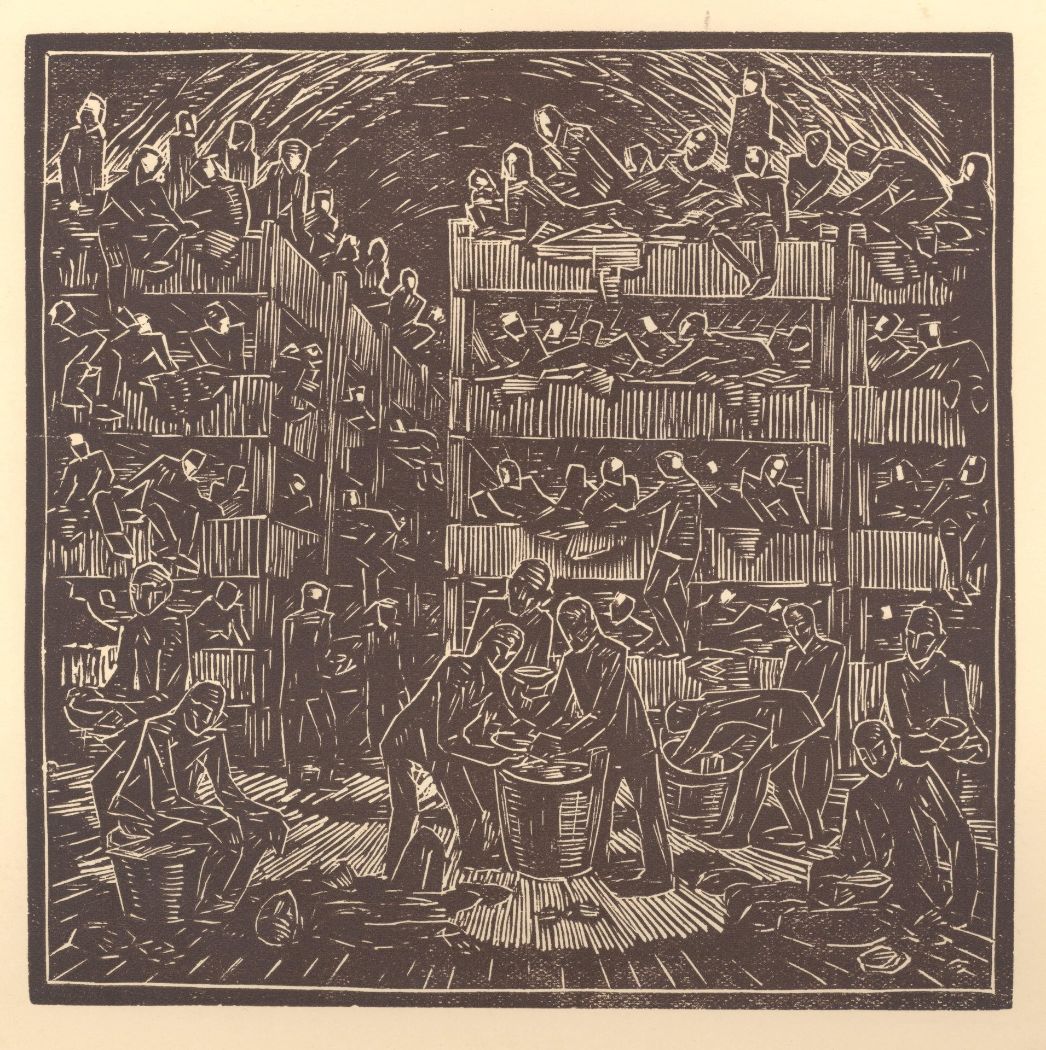
In a series of five woodcuts executed eight years after the war’s end, the Czech painter Dominik Černý bore witness to the cruelties he had suffered at the Mittelbau-Dora concentration camp: the horrors of life, work, and mass death in the tunnel in Kohnstein Mountain in Northern Thuringia.
His woodcut K.L. Dora: Bydlení ve štole (Living in the Tunnel) describes the cramped conditions on the plank beds and in the tunnel. The people are depicted as silhouettes without individual features. Often the heads are marked merely with white dots, the faces unrecognizable. From this virtually amorphous mass, certain situations have been singled out by way of example. One man is sitting on a barrel to relieve himself, another is lying dead on the floor in front of him, a third is scraping out a food bucket, a fourth is sitting on the floor and eating.
In existence from 1943 onwards, the Mittelbau-Dora concentration camp was the last of the parent camps to be established by the Nazis. It was also one of the first—and at the end of the war by far the largest—concentration camp to have been founded solely with the aim of exploiting its inmates’ manpower for armaments production.
Established by the Buchenwald concentration camp, “Dora” was initially not a camp in the strict sense. That is because the inmates put to work there converting a tunnel into an underground rocket factory were also made to live at their workplace: the tunnel. It was only after the rocket assembly operations had gotten underway in early 1944 that they were gradually moved to the aboveground barracks camp as its construction progressed. Their underground lodgings consisted of four transverse tunnel chambers furnished with four-tiered plank beds. These so-called “sleeping tunnels” for altogether ten thousand human beings were dark, damp, stuffy, dirty, and had no sanitary facilities. The inmates’ clothing was tattered and, like the straw sacks used as bedding, infested with vermin.
The inhabitants of these caves were forced to perform heavy physical labour in the direct vicinity of their sleeping quarters. In alternating twelve-hour day and night shifts, they carried out excavation and levelling work, in part with air hammers, and transported the stone out in wagons. More than 5,000 inmates died in April 1944 alone. By the summer of that year, the SS had moved the survivors to the barracks camp. The dying continued nevertheless. Of the altogether 60,000 inmates of the Mittelbau-Dora concentration camp, 20,000 lost their lives there.
The woodcut series on the “Dora” concentration camp carried out by Dominik Černý in 1953 not only visualizes the disastrous conditions in the tunnels, but also commemorates all of the ill-treated and murdered inmates whose vital energy was pressed out of them to build rockets for Nazi Germany, and whose existences were obliterated in the tunnels.
Biography
Dominik Černý was born in Chrlice near Brno on 4 August 1903. He trained as a teacher in Brno and subsequently worked in that profession in Southern Moravia. He settled in Hluk, pursued his interest in ethnographic studies, and recorded the landscape and people of his native Moravia in drawings and watercolours. Under the German occupation he joined the Czech resistance and was deported to the Auschwitz concentration camp in October 1942. In the so-called “camp museum” he carried out paintings on commission from the SS. In August 1943 the SS transferred him to Buchenwald and a few weeks later from there to the “Dora” subcamp.
After the camp’s liberation, Dominik Černý returned to Hluk. In 1951 and 1953 he published the woodcut series Oswientim and K.L. Dora-Sangerhausen. He made a name for himself as an impassioned painter of his region. He retired in 1963 and died in Hluk on 13 June 1973.

